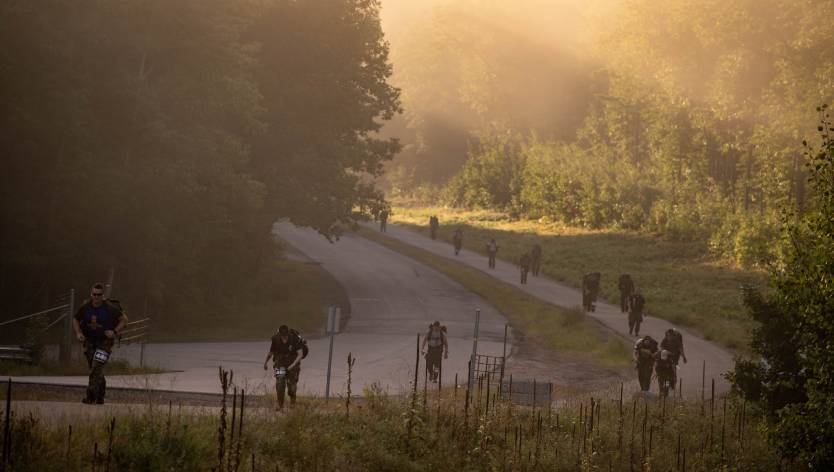The Iron Warrior is no ordinary race. For the past 40 years, it has been the marquee event of 2 CMBG, and helps contribute to esprit de corps and a proud tradition of competition and physical fitness. The event usually tales place at 2 CMBG headquarters in Petawawa, in late August.
The marathon version consists of an initial ruck march of 25.92 km, followed by a 2.6-km portage, a canoe journey of 8.2 km, and a final 6.28-km ruck march to the finish line for a total of 42 km.
In past years, the competition invited hundreds of Canadian Armed Forces (CAF) personnel, but due to the pandemic numbers were reduced.
An average ruck sack weighs between 25 and 35 pounds depending on the competitor’s weight.
The sprint version of Iron Warrior consists of a 9.02 km ruck march, a 1-km portage, a canoe trip of 4.7 km, and finally a 6.28-km ruck march to cross the finish line for a total of 21 km.
Due to increased concern about the rate of injuries sustained by participants in this annual event, for the 2020 version of Iron Warrior, a number of simple injury reduction strategies were put in place. These included reducing the distances covered, decreasing the weight participants had to carry and giving participants the option to wear running shoes instead of combat boots.
While the changes did not alter the challenging nature of the event Dr. Darrell Menard, a medical specialist in sports medicine for the Canadian Forces, says they had a profound impact on participants.
“They significantly reduced the number of injuries sustained by participants,” Menard says. “There was a six-fold reduction to injuries.”
Regardless, whether competing in the marathon or the sprint, this is not something that should be decided at the last minute. A race of this magnitude requires incredible endurance, both mentally and physically, and this is where the Health Promotion team comes into play.
“We really wanted to push for the health and wellness of competitors,” says Juannittah Kamera, Manager Health Promotion, Personnel Support Programs (PSP) 4th Canadian Division Support Group, Petawawa. “The goal is to help them stay safe.”
The average runner takes between 16 and 20 weeks to prepare for a marathon, and that’s without carrying the additional weight of a rucksack or portaging a canoe.
While competitors can take part in a 12-week training regimen provided by the local PSP Fitness team to prepare for the Iron Warrior, the Health Promotion team also identified a need for nutritional education.
“We wanted to see how we could be more intentional in preparation for Iron Warrior,” says Adeline Mutembanema, a health promotion specialist, PSP – Garrison Petawawa. “There was a gap identified that nutrition needed to be better in preparation for the event.”
In addition to working with individuals on the importance of nutrition, the team provides hydration sessions as well.
“We need people to understand training for combat and fitness is different,” says Denver Hilland, a health promotion specialist.
François Thériault, the National Manager for Health Promotion, admits the results from working collaboratively with senior leadership is extremely beneficial.
“Working collaboratively helps remove barriers to health and wellness,” he says. “In this case, you’re sort of removing the force aspects of the competition that were more injury prone while maintaining the competitive spirit of it.”
While most participants lead a fairly active lifestyle, the Health Promotions Team are successfully working with unit leadership to deliver the nutrition brief to their participants early on in their training preparations and provide ongoing support throughout their training period.
A marathon puts the body into overdrive, uses energy stores, breaks down muscle and loses fluid and electrolytes. While training prior to the event is critical, the post-race recovery is just as important.
In an effort to support recovery the Health Promotion team collaborates with the designated food services OPI to ensure there are a number of hydration stations throughout the course stocked with fruits, water and electrolytes for participants to refuel and recover. There is overall support for competitors in the hope of reduced injury and mental well-being.
Dr. Menard commends the collaboration between senior leadership and the Health Promotion team.
“This is a wonderful example of how teamwork and leadership can play a substantial role in reducing injuries in CAF personnel.”
For the members of the health promotion team working collaboratively with competitors has been extremely rewarding.
“It was a lot of fun seeing members cross the finish line and chat with us about the race,” says Hilland. “It’s incredibly fulfilling being able to support members achieve their goals, but also help reduce their risk of injury or experiencing negative health outcomes from the event.”
If you want to empower members under your command so that they can improve their health, contact the CAF Health Promotion program; their staff can help you identify barriers to health and wellness within your lines, and support you with initiatives that can contribute to meaningful change.


